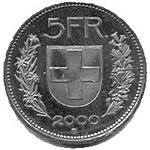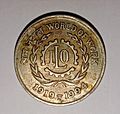Cupronickel facts for kids
Cupronickel (also called copper-nickel) is a special type of alloy. An alloy is a mix of two or more metals. Cupronickel is mostly copper, but it also has nickel. It often includes small amounts of iron and manganese to make it stronger. Even though it has a lot of copper, cupronickel looks silver in color.
This metal mix is very useful because of its unique features. Industries like coin making, defense, and water treatment use it a lot. It's also common in marine engineering, and in chemical and electrical industries.
Cupronickel is great at resisting rust, especially in seawater. Because of this, it's used for pipes and parts in ships. You can find it in heat exchangers and condensers on boats. Sometimes, it's even used for propellers, crankshafts, and the hulls of strong tugboats and fishing boats.
Another common use for cupronickel is in modern silver-colored coins. A typical mix for coins is 75% copper and 25% nickel. It also has a tiny bit of manganese. Long ago, real silver coins were sometimes mixed with cupronickel to make them cheaper. This was called debasement.
What's in a Name?
Besides "cupronickel" and "copper-nickel," this metal has other names. Some old trade names are Alpaka or Alpacca, Argentan Minargent. The French term cuivre blanc means "white copper." You might also hear it called hotel silver or German silver. In Spanish, it's plata alemana, which also means "German silver." Sometimes, it's even called Chinese silver.
Cupronickel Coins
Cupronickel is excellent for making coins for many reasons. It doesn't rust easily and conducts electricity well. It is also very strong and can be shaped easily. This metal is safe for people, as it rarely causes allergies. It's also easy to stamp into coin shapes and can be recycled.
The United States Mint first used cupronickel for coins in 1865. This happened partly because people were saving silver during the Civil War. Then, in 1866, they started making five-cent coins from cupronickel. Before these dates, both these coins were only made from silver in the U.S.
Images for kids
-
A 5 Indian rupees coin, celebrating the ILO.
See also
 In Spanish: Cuproníquel para niños
In Spanish: Cuproníquel para niños




